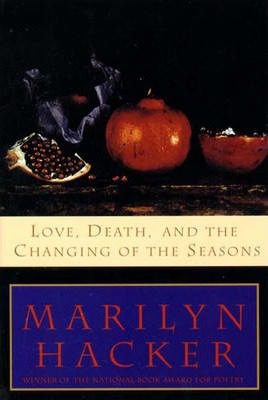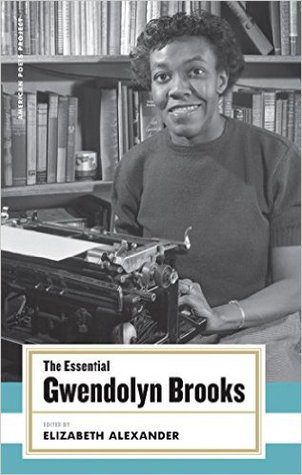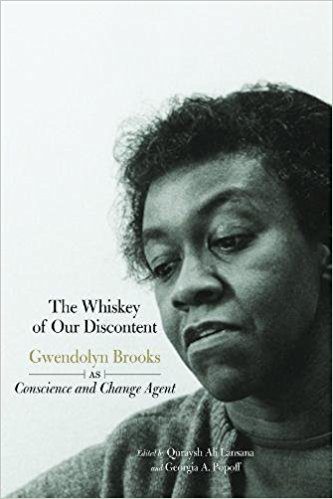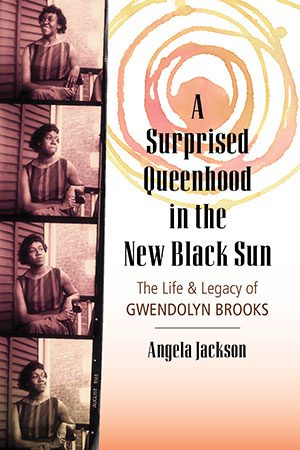I.
For at least two months, I have been haunted by Gwendolyn Brooks. Haunted in all of the best ways. First it was the collection of critical writings about Brooks. Then the issue of Poetry Magazine. Then I heard tell of a biography of Brooks; this morning I found the title. Soon I will be reading it.
One of my favorite moments in the history of women’s music is when Cris Williamson is recording her Circle of Friends album in a live performance at the Zellerbach Auditorium in Berkeley, CA in 1990. Near the end of the concert, Williamson is performing her song, “Shooting Star,” which begins with the lyrics: “Thunder is shaking the roof of my car / I would go through a desert for you.” Suddenly Vicki Randle and Theresa Trull enter the stage singing with Williamson. The audience goes crazy with applause, adoration. Williamson is shocked at first, then delighted. Happy, laughing. She shouts out “My girlfriends!” I was not there; I was too young. I hear this moment only on the recording: first a cassette tape, then a compact disc, now it lives on my computer. At the end of the song, Williamson tells the audience, “All of a sudden I hear this voice coming in. Oh, my god! We’ve had a visitation. Ah! I have the best friends in the world.” Williamson’s words, “We’ve had a visitation,” live large in my consciousness.
A visitation is how I describe the past weeks walking with Gwendolyn Books. It is like she is just around every corner. Lurking in the back of my mind. I can almost see her again, even as I never saw her ever the first time she was walking here on earth. Still she occupies my mind, flitting in and out of my peripheral vision. A visitation.
II.
As a young reader, with fewer books read, when I discovered a poet, I could read not only the book of discovery but also back through all of the earlier work. The discovery of Marilyn Hacker’s Love, Death, and the Changing of the Seasons lead me through a period of having ample poetry by Hacker to fill my eyes and ears. Similarly, Mary Oliver’s American Primitive opened the door to the world of her poetry. Toi Derricotte. Donald Hall. Ai. June Jordan. I read them mid-career, backward, then forward.
Discovering a poet mid-career, particularly as a young reader, is exciting. First, there are the earlier books to read. The thrill of tracking down each volume, either through the library or at bookstores. Reading the poems one by one; considering the book, the poems collected into one room to speak to one another; ordering the books; tracking the development of the poet as if to imagine one’s own future. Then the anticipation of new books. Waiting for a poet’s next book of poetry is sacred. Prior to our digitally connected lives, to our immediately ability to search the web, to see books in advance of their publication date on any number of bookselling websites or in the trade journals Publishers Weekly, Booklist, and others, the announcement of a new book came through booksellers or through print magazines. Sometimes, even, from the poets themselves. Announcements were slow, building greater anticipation and greater desire. Poems did not come daily into email boxes, they arrived by truck in plain brown boxes, shipped to local bookstores where booksellers unpacked them and order them on shelves. Usually, for poetry a shelf in the back, away from the crowds in a place where one could crouch down and finger the pages. Silently, read a few poems. Books had heft. They had weight in the world. We carried them in satchels and book bags. Poetic matter occupied space and time in the world, physically manifest before occupying our minds.
In the late 1980s, when I finished reading all of the published work of Hacker, I had this exchange with my best friend and fellow poetry reader more than a hundred times:
Guess what!
What?
Guess who has a new book of poetry coming out?
Marilyn Hacker.
No, <insert some other poet’s name here>!
We would both squeal with excitement. New books of poetry, particularly clothbound books with their beautiful dust jackets and sewn pages, were a source of joy and excitement. The new book by another poet surely meant that Marilyn Hacker’s book was closer, however in some ether just waiting to incarnate with soy ink and recycled paper. The delay made anticipation more intense—and sweeter. Eventually the day arrived. The final line of that exchange was a single word: Yes. A new book of poetry by Marilyn Hacker wending its way into the world. For me, to this day, there is never a greater life event than a new book of poetry by Marilyn Hacker.
III.
Equal to the excitement of discovering a new poet mid-career is the pleasure of discovering a poet who has recently passed. Discovering a poet at the end of her life provides an opportunity to read and consider their entire oeuvre in a focused period of time. This is how I read and discovered Carolyn Kizer, “From Sappho to myself, consider the fate of women.” As I read her in the early 2000s, she was picketing Woolworth’s taking me back to an earlier moment of poet’s activism:
It is mysterious to many, even now:
Thirty-six people sweating and circling
Woolworth’s on a summer’s day, in a Northern town.
Three spectators ask: What Is Segregation?
You Should Be Ashamed!!! SIT-INS. What’s them?
Laboriously picking out syllables
Kizer was talking with union women, singing “O Solidarity! O Feminism!,” even as she revealed its disappointments “ignored, outvoted” and still celebrated “Solidarity, cinquains, brave bearded ladies—Hooray!”
I read Lucille Clifton the same way: in a thick, clothbound book with onion-skin pages. Clifton from BOA Editions; Kizer from Copper Canyon. Both publishers are national treasures. Clifton delighted me: “nobody warned me about daughters; / how they bewitch you into believing / you have thrown off a pot that is yourself.” Though, of course, the daughter is not yourself. She is her own self who will love you and hate you and disappoint you and delight you. Clifton captured a world of mothers and daughters that felt true, authentic in both its love and its pain.
Like Kizer, Clifton grappled with girlhood and womanhood writing,
she has waited
patient as a nun
for the second coming,
when she can break through gray hairs
into blossomand her lovers will harvest
honey and thyme
and the woods will be wild
with the damn wonder of it.
I have always wanted my lovers to harvest honey and thyme, though their labor has veered more to email, legal briefs, and other office activities. Thanks to Clifton, though, even these labors in cubicles and on long yellow paper are wild in my mind; thanks to Clifton, I cultivate wonder.
In “my dream about falling,” Clifton images an apple always in blossom and a tree forever fruitful then wryly observes: “the fact is the falling. / the dream is the tree.” Dreams and visitations. Are you beginning to see a theme?
IV.
Visitations raise many questions. What happens to our beloved poets after they pass? How do we keep their memories alive? How do we continue to love and honor and study their work? How do we share it with others, ensuring a life for poems beyond the end of the poet’s body? Not everyone can see ghosts. Not everyone is haunted by poets of the past.
In publishing and scholarship, a sequence emerges for poets to persist, for their work to be preserved. First, a complete works. Though a complete works, those thick books that gather and catalogue a poet’s complete output, seems to be an empty space for Brooks. Readers can cherish The Essential Gwendolyn Brooks from the Library of America’s American Poets Project, expertly edited by Elizabeth Alexander. They can revisit Brooks’s own Selected Poems. As of yet, though, there is no inch or two or three clothbound book to sit on the shelf and rest heavily on readers’ laps while exploring Brooks’s whole poetic trajectory as an American master.
Then publications of letters, journals, a critical collection or two or more. The flowering of a poet posthumously may be best observed in Elizabeth Bishop. Her slender lifetime poetic output now the subject of dozens and dozens of books: her correspondence with Robert “Cal” Lowell; her correspondence with the New Yorker; a new book about Bishop at work; and multiple biographies with different approaches and variable lenses. The ink spilled on Bishop soon will fill the Amazon or possibly color all of the trees she and Lota overlooked in Petrópolis at their beloved home a Fazenda Samambaia. Bishop passed in 1979; Brooks in 2000. May Brooks’s life be inked as fully as Bishop’s in the years to come.
V.
This past June’s celebration of Brooks at one hundred started auspiciously. Quraysh Ali Lansana and Georgia A. Popoff’s The Whiskey of Our Discontent: Gwendolyn Brooks as Conscience and Change Agent is a wonderful book of scholars and poets reading and responding to Brooks. The Whiskey of Our Discontent demonstrates the vibrancy of engagements with Brooks. In the introduction, Sonia Sanchez situates Brooks with Du Bois and Frantz Fanon; she challenges readers to resistance: “We the lovers of selves, the lovers of justice and freedom and democracy will turn and say, we resisted like Sister Gwen resisted.” Sanchez then reveals the continued power of Brooks’s poems:
[E]ach time I read Miss Brooks, each time I revisit her poems, they climb up on my knees and sit in tight contentment. They speak to me of form and color, patterns and dawns. They talk of myths; they tell me where flesh lives, where a troop of young heroes and sheroes lean back in chairs.
With contributions by Tara Betts, Antoinette Brim, R. J. Eldridge, James Allen Hall, Patricia Spears Jones, and many others, this book sparkles with engaging Brooks, her poems, and the work of her lifetime.
The final two essays are organized under the rubric “Legacy.” Major Jackson reports on the Pulitzer Jury that awarded Brooks the prize for her second collection Annie Allen. Jackson demonstrates how the prize was “as much a reflection of cultural networks (including friendships), personal tastes, aesthetic alliances, and—not surprisingly—even political agendas.” Not a surprising conclusion, but it demonstrates the significance of collections like The Whiskey of Our Discontent to continue to preserve author’s works in the public sphere. Books like this collection create cultural networks, shape aesthetic alliances, and even political agenda.
Similarly, Lansana’s essay, “Concealed and Carried: Brooks’s Loaded Boxes,” describes the curious manner in which part of the papers of Brooks landed at the Bancroft. Everyone who has worked in archives knows they are political spaces—contested, celebrated, contained, curated. They shape what we come to know and understand as history.
VI.
Poet’s personal histories, their lives, how they organized them—or did not—to create the time and space for poetry, always interest me. A new biography of Brooks is part of the publishing occasion of Gwendolyn Brooks at one hundred. Angela Jackson’s A Surprised Queenhood in the New Black Son: The Life & Legacy of Gwendolyn Brooks assembles the life of Brooks from her own autobiographies, Report from Part One (published by Broadside Press) and Report from Part Two (published by Third World Press), the previous biography by George Kent, personal interviews with people who knew Brooks, and Brooks’s poems. With these sources, Jackson weaves a compelling narrative. A Surprised Queenhood sings when Jackson offers close readings of Brooks’s poems to explore the social, cultural, and political context of Brooks’s life. Jackson’s readings of poems from A Street in Bronzeville as expressive of the life of Brooks and her husband Harry are moving and powerful as are her readings of Annie Allen, Brooks’s novel Maud Martha, and The Bean Eaters.
Jackson documents the extraordinary generosity of Brooks, not only in mentoring other poets and giving time and attention to students, but also in providing concrete financial support for poets and writers. Brooks gave literary prizes to students in Chicago Public Schools beginning in the 1960s and expanded her funded of literary prizes to writers through the Illinois Arts Council in the 1970s. She also funded literary awards through Black World magazine, and made direct grants to writers to send them to Africa “for their enrichment.” Brooks’s generosity knew no bounds—and serves as an inspiration for writers working today.
In addition to capturing the individual life of Brooks, A Surprised Queenhood explores with great power and meaning the changing contexts of blackness during Brooks’s lifetime. Born in 1917, Brooks began publishing during the World War II. Her first poems in Poetry appeared in 1944. Black World magazine began publishing in 1942 as Negro Digest. During the next thirty years, the language, political attentions, and cultural contexts of black people changed dramatically. Jackson traces these changing contexts and Brooks’s responses with deftness throughout A Surprised Queenhood. She captures the vibrancy of intergenerational relationships for Brooks—and for younger writers:
She taught them craft; they had no interest in writing for white people, or in hearing what white people had to say about their work. They taught Gwendolyn the way the world now worked. She had some understanding, but it was limited in their eyes. They wanted her to see things from a black position, without equivocation. They wanted her to understand the systemic nature of racism, how it was rooted in white hegemony, a rock-hearted white supremacy, and that supremacy was undergirded by economic exploitation and inequity. Gwendolyn was standing on a mountaintop and could now see in all directions.
Slowly, they influenced her. Without their telling her to, she let her hair be in its natural state, an Afro, and so announced that she was standing up for being black.
Vibrancy characterizes Brooks life in the world. At every step of her life she engaged with passion, intention, and beauty. A Surprised Queenhood captures the vibrancy of brooks.
Brooks’s meaningful engagements with other writers crescendos to the final chapter, “Immortality of a Kind.” Jackson begins, “Poets and writers are immortal; they live as long as their words are spoken and speak to people.” Jackson animates Brooks’s immortality with extended quotations from people influenced by Brooks including Haki Madhubuti, Reginald Gibbons, Patricia Spear Jones, Sonia Sanchez, and many others. Tribute, people paying tribute, is one of the characteristics of Gwendolyn Brooks at one hundred. Tributes conjure Brooks from the past for our present.
VII.
In The Whiskey of Our Discontent, poets and critics pay tribute to Brooks in prose; Angela Jackson conjures tributes in service to biography, to animate the profound influence of Brooks’s life on others. In The Golden Shovel Anthology, poets pay tribute to Brooks with poems and by popularizing a new poetic form that pays tribute to Brooks. Terrance Hayes captures the vitality of the collection in the opening lines of the foreword: “Where do poems come from if not other poems? Where do forms come from if not other forms?”
The form Golden Shovel embeds a poem, or lines from a poem, within a new poem; the final words of each line of the new poem are taken from the inspiration poem. The inspiration poem, or lines from it, can be read down the right hand side of the poem while the new poem is read in the tradition way from left to right. The Golden Shovel form comes from Terrance Hayes poem, “The Golden Shovel,” which embeds Brooks’s poem “We Real Cool.” Ravi Shankar, one of the editors of The Golden Shovel Anthology, notes, “The Golden Shovel has all the characteristics to be one of the quintessential twenty-first-century forms, one that will last well beyond its moment of inception to take its place in the history of poetic prosody. It’s one of the few forms that work both horizontally and vertically, a form that can be seen as a kind of verbal Sudoku. It demands an acrostic and cerebral engagement.”
The Golden Shovel Anthology certainly will contribute to the endurance of the form. The Anthology opens with a few of Brooks’s poems and Hayes’s generative poem, “The Golden Shovel.” After those works are more than three hundred poems in the form of the Golden Shovel by as many poets. The editors, high school teacher and poet Peter Kahn, poet, publisher, and translator Ravi Shankar, and poet-scholar Patricia Smith, organize the poems alphabetically according to the poem by Brooks that inspired the poet. Four poets including LaTasha N. Nevada Diggs and Maxine Kumin respond to Brooks’s “Bronzeville Woman in a Red Hat.” Six poets including Sandra Beasley and Danez Smith respond to Brooks’s “Gay Chaps at a Bar.” Eleven poets including Jehanne Dubrow, Gail Mazur, and Sharon Olds respond to Brooks’s “The Mother.” At the end of the collection are Golden Shovel poems that respond to other poets and Golden Shovel poems that extend and play with the form itself. It is a heady collection full of discoveries about Brooks and about contemporary poetry.
Gwendolyn Brooks at one hundred, a curated collection of books, a dedicated issue of the journal Poetry, celebrations and events, is another archive of Brooks’s work and the continued public reception of her work. Call it an archive, call it a celebration, call it a séance; it enlivens Brooks in our lives and our cultural imaginations.
VIII.
Reading the responses of contemporary poets and scholars and writers and editors to Brooks over the past few months has delighted me. This work, shaping essays, writing new poems, researching the past, telling stories about it all, is how writers stay alive. All writers. Yes, these works animate Brooks’s life and work; they also give life and energy to their authors. As writers, we fill our own wells by reading and writing about other writers. We want “a journal or a friend or an illegal kiss.” Brooks knew this. She wrote in “The Womanhood”:
Life for my child is simple, and is good.
He knows his wish. Yes, but that is not all.
Because I know mine too.
And we both want joy of undeep and unabiding things,
Like kicking over a chair or throwing blocks out of a window
Or tipping over an icebox pan
Or snatching down curtains or fingering an electric outlet
Or a journey or a friend or an illegal kiss.
No. There is more to it than that.
It is that he has never been afraid.
Rather, he reaches out and lo the chair falls with a beautiful crash,
And the blocks fall, down on the people’s heads,
And the water comes sloshing sloppily out across the floor.
And so forth.
Not that success, for him, is sure, infallible.
But never has he been afraid to reach.
His lesions are legion.
But reaching is his rule.
The poem might begin, Life for a writer is simple, and is good. The celebration of Gwendolyn Brooks at one hundred provides “joy of undeep and unabiding things” as well as joy in deep and abiding things. For Brooks’s child, reaching is the rule; likewise for Brooks and for all of us: never be afraid to reach. Find joy in undeep and unabiding things.








